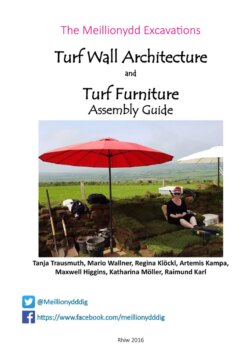Turf Wall Architecture and Turf Furniture Assembly Guide

Реклама. ООО «ЛитРес», ИНН: 7719571260.
Оглавление
Tanja Trausmuth. Turf Wall Architecture and Turf Furniture Assembly Guide
Turf Wall Architecture and Turf Furniture Assembly Guide
Impressum
Archaeology and Turf Walls
Building Blocks: Turf Bricks
Tulls (Turf Walls)
Step 1: Laying out the tull base
Step 2: Adding a second layer of turf bricks
Step 3: Adding a third layer of turf bricks
Step 4: Repeat steps 2 and 3
Step 5: Capping the tull
Stabilised tull ends
Stepped tull ends
Advanced Turfitecture
Turniture (Turf Furniture)
The Tofa (Turf Sofa)
Step 1: Laying out the tofa base
Step 2: Raising the tofa base to the right level
Step 3: Adding turf cushions
Step 4: Adding an armrest
Step 5: Adding a backrest
Step 6: Adding the second armrest
Step 7: Cutting cupholders
The Tair (Turf Chair) and Tench (Turf Bench)
The Touffe (Turf Pouffe)
The Turble (Turf Table)
The Ted (Turf Bed)
Bibliography
Postscriptum
Отрывок из книги
Turf and soil removal and storage are one of the most important aspects of archaeological excavation site management (Barker 1993, 129-30; Drewett 1999, 104-5; Collis 2001, 31-4, 56; Roskams 2001, 101-4). Considerable attention is paid by the standard excavation textbooks to spoil management in particular. Comparatively little attention, on the other hand, is given to turf management: more recently published excavation manuals (Drewett 1999; Collis 2001; Roskams 2001) do not even mention it. Only Barker (1993, 129) gives a short description of turf storage in his textbook on excavation techniques, which was originally published in 1977.
When excavating in areas of outstanding natural beauty, uplands or on pastures, turf management and storage are particularly important. Since the trenches have to be re-turfed after the excavation has been finished, with the turf being put over the top of the backfilled trenches, it needs to be stored close to the site and in a way that allows the turf to be put back reasonably quickly and efficiently. Barker (1993, 129) thus recommends quite sensibly that ‘the turf should be cut carefully and stacked, grass face to grass face, well away from the rest of the spoil, and should be kept damp’. For reasons of efficiency, turf is most commonly stacked in forms of walls that extend along the edge of trenches, usually a few metres away from them. This keeps the distance they need to be carried short, and more often than not serves other useful purposes, e.g. to lean currently unused tools against. Particularly in exposed locations, they can also be useful as a shield against prevailing winds and driving rains, especially during breaks taken on site, whether out of convenience or necessity (as e.g. in upland locations far from the beaten tracks).
.....
As e.g. Collis (2001, 47) remarks, excavating should be fun and excavations should generally be an enjoyable experience for everyone, whether site staff or visitors, and thus, anything that can be done to improve the experience is useful. In the following pages, we would like to outline a few improvements we have developed in the fields turf wall architecture (turfitecture) and turf furniture (turniture) design. The guidance in the following pages is, of course, ever so slightly tongue in cheek, but we hope that readers will be able to take some inspiration from it to improve their own sites, as indeed some other excavations have already started to do (fig. 1). For ease of use, we include step- by-step instructions for constructing professionally built turf walls (tulls) and a number of pieces of turniture.
Fig. 1: Turf wall (tull) enclosure built at the CADW, MMU and UCLan excavations at Bryn Celli Ddu, Anglesey, inspired by the Meillionydd turfitecture and turniture (image: Rhys Mwyn).
.....